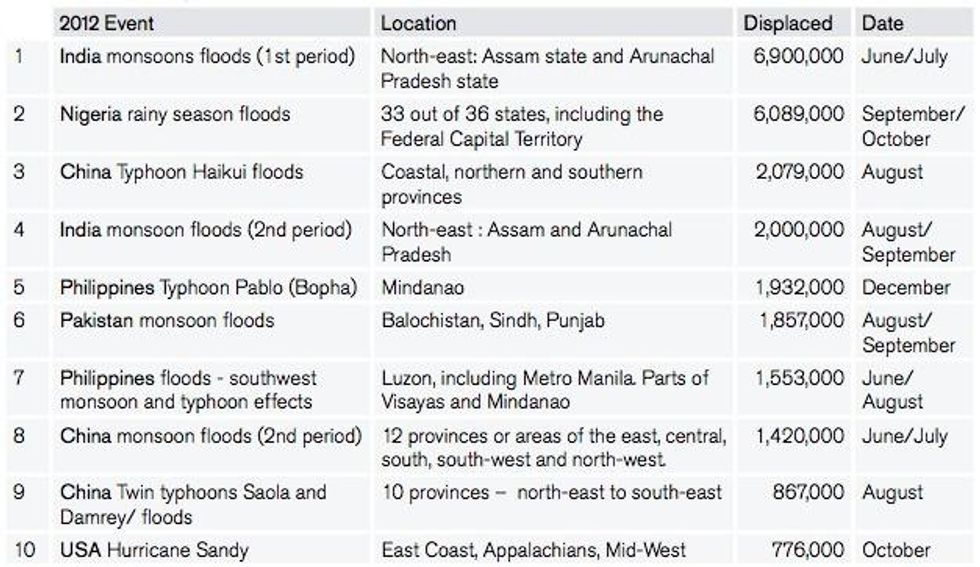Will Climate Change Make You Homeless?
New report: disasters displaced 32.4 million people in 2012, with most due to weather- or climate-related disasters

According to the assessment released Monday from the Internal Displacement Monitoring Centre (IDMC), disasters displaced 32.4 million people in 82 countries last year, with most--98%--being the result of weather- or climate-related disasters likes floods and wildfires.
Call them "IDPs" (internally displaced persons) or "refugees," and it's tempting for those who have as of yet been unscathed by such disasters to see displacement as a distant problem. But as the world reaps more and more of what the world's fossil fuel addiction has sown, the distance may be shrinking.
From the report:
In the longer term, human-induced climate change is expected to increase the frequency and severity of weather-related hazards, including floods, storms, wildfires and droughts which contribute to most disaster-induced displacement
As Hurricane Sandy showed, climate refugees aren't limited to the developing world. Over three-quarters of a million people in the U.S. were displaced in 2012 by "the costliest storm disaster" in the nation's history, the report states.
And "in countries already facing the effects of conflict and food insecurity such as in Nigeria, Pakistan, and South Sudan, we observe a common theme," Clare Spurrell, Chief Spokesperson for IDMC, said in a statement. "Here, vulnerability to disaster triggered by floods is frequently further compounded by hunger, poverty and violence; resulting in a 'perfect storm' of risk factors that lead to displacement.''
The top 10 disaster-induced displacement events in 2012 according the report:

To better respond in the future, communities and governments need better data collection on the displaced people, the IDCM states. "Currently the information available is biased, often only focusing on the most visible people who take shelter in official evacuation sites or camps," stated Spurrell, and the report notes that "Some IDP s are also less visible, particularly those in female-headed households, older persons and those with disabilities."
Spurrell says that "We need to know more about those who seek refuge with families and friends, people who are repeatedly displaced by smaller disasters, or those who are stuck in prolonged displacement following a disaster - not just those that make headlines."
___________________________
An Urgent Message From Our Co-Founder
Dear Common Dreams reader, The U.S. is on a fast track to authoritarianism like nothing I've ever seen. Meanwhile, corporate news outlets are utterly capitulating to Trump, twisting their coverage to avoid drawing his ire while lining up to stuff cash in his pockets. That's why I believe that Common Dreams is doing the best and most consequential reporting that we've ever done. Our small but mighty team is a progressive reporting powerhouse, covering the news every day that the corporate media never will. Our mission has always been simple: To inform. To inspire. And to ignite change for the common good. Now here's the key piece that I want all our readers to understand: None of this would be possible without your financial support. That's not just some fundraising cliche. It's the absolute and literal truth. We don't accept corporate advertising and never will. We don't have a paywall because we don't think people should be blocked from critical news based on their ability to pay. Everything we do is funded by the donations of readers like you. Will you donate now to help power the nonprofit, independent reporting of Common Dreams? Thank you for being a vital member of our community. Together, we can keep independent journalism alive when it’s needed most. - Craig Brown, Co-founder |

According to the assessment released Monday from the Internal Displacement Monitoring Centre (IDMC), disasters displaced 32.4 million people in 82 countries last year, with most--98%--being the result of weather- or climate-related disasters likes floods and wildfires.
Call them "IDPs" (internally displaced persons) or "refugees," and it's tempting for those who have as of yet been unscathed by such disasters to see displacement as a distant problem. But as the world reaps more and more of what the world's fossil fuel addiction has sown, the distance may be shrinking.
From the report:
In the longer term, human-induced climate change is expected to increase the frequency and severity of weather-related hazards, including floods, storms, wildfires and droughts which contribute to most disaster-induced displacement
As Hurricane Sandy showed, climate refugees aren't limited to the developing world. Over three-quarters of a million people in the U.S. were displaced in 2012 by "the costliest storm disaster" in the nation's history, the report states.
And "in countries already facing the effects of conflict and food insecurity such as in Nigeria, Pakistan, and South Sudan, we observe a common theme," Clare Spurrell, Chief Spokesperson for IDMC, said in a statement. "Here, vulnerability to disaster triggered by floods is frequently further compounded by hunger, poverty and violence; resulting in a 'perfect storm' of risk factors that lead to displacement.''
The top 10 disaster-induced displacement events in 2012 according the report:

To better respond in the future, communities and governments need better data collection on the displaced people, the IDCM states. "Currently the information available is biased, often only focusing on the most visible people who take shelter in official evacuation sites or camps," stated Spurrell, and the report notes that "Some IDP s are also less visible, particularly those in female-headed households, older persons and those with disabilities."
Spurrell says that "We need to know more about those who seek refuge with families and friends, people who are repeatedly displaced by smaller disasters, or those who are stuck in prolonged displacement following a disaster - not just those that make headlines."
___________________________

According to the assessment released Monday from the Internal Displacement Monitoring Centre (IDMC), disasters displaced 32.4 million people in 82 countries last year, with most--98%--being the result of weather- or climate-related disasters likes floods and wildfires.
Call them "IDPs" (internally displaced persons) or "refugees," and it's tempting for those who have as of yet been unscathed by such disasters to see displacement as a distant problem. But as the world reaps more and more of what the world's fossil fuel addiction has sown, the distance may be shrinking.
From the report:
In the longer term, human-induced climate change is expected to increase the frequency and severity of weather-related hazards, including floods, storms, wildfires and droughts which contribute to most disaster-induced displacement
As Hurricane Sandy showed, climate refugees aren't limited to the developing world. Over three-quarters of a million people in the U.S. were displaced in 2012 by "the costliest storm disaster" in the nation's history, the report states.
And "in countries already facing the effects of conflict and food insecurity such as in Nigeria, Pakistan, and South Sudan, we observe a common theme," Clare Spurrell, Chief Spokesperson for IDMC, said in a statement. "Here, vulnerability to disaster triggered by floods is frequently further compounded by hunger, poverty and violence; resulting in a 'perfect storm' of risk factors that lead to displacement.''
The top 10 disaster-induced displacement events in 2012 according the report:

To better respond in the future, communities and governments need better data collection on the displaced people, the IDCM states. "Currently the information available is biased, often only focusing on the most visible people who take shelter in official evacuation sites or camps," stated Spurrell, and the report notes that "Some IDP s are also less visible, particularly those in female-headed households, older persons and those with disabilities."
Spurrell says that "We need to know more about those who seek refuge with families and friends, people who are repeatedly displaced by smaller disasters, or those who are stuck in prolonged displacement following a disaster - not just those that make headlines."
___________________________

